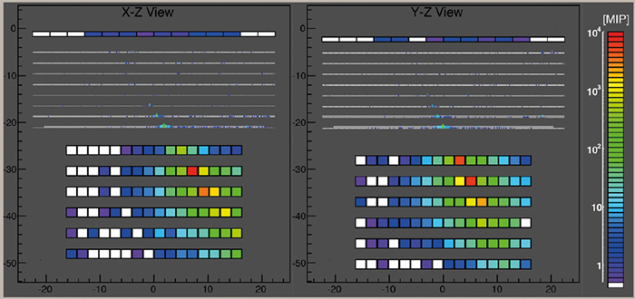
Image credit: CALET Collaboration.
Just a few months after its launch and the successful completion of the on-orbit commissioning phase aboard the International Space Station, the CALorimetric Electron Telescope (CALET) has started observations of high-energy charged particles and photons coming from space. To date, more than a hundred million events at energies above 10 GeV have been recorded and are under study.
CALET is a space mission led by JAXA with the participation of the Italian Space Agency (ASI) and NASA. CALET is also a CERN-recognised experiment; the collaboration used CERN’s beams to calibrate the instrument, which was launched from the Tanegashima Space Center on 19 August 2015, on board the Japanese H2-B rocket. After berthing with the ISS a few days later, CALET was robotically extracted from the transfer-vehicle HTV5, operated by JAXA, and installed on the external platform JEM-EF of the Japanese module (KIBO). The check-out phase went smoothly, and after data calibration and verification, CALET moved to regular observation mode in mid-October 2015. The data-taking will go on for period of two years, initially, with a target of five years.
The first data sets are confirming that all of the instruments are working extremely well.
CALET is designed to study electrons, nuclei and γ-rays coming from space. In particular, one of its main goals is to perform precision measurements of the detailed shape of the electron spectrum above 1 TeV. High-energy electrons are expected to come from less than a few-thousand light-years from Earth, as they quickly lose energy travelling in space. Their detection might reveal the presence of nearby astronomical source(s) where electrons are accelerated. The high end of the spectrum is particularly interesting because it could provide a clue to possible signatures of dark matter.
The first data sets are confirming that all of the instruments are working extremely well. The event image above (raw data) shows the detailed shape of the development of a shower of secondary particles generated by the impact of a candidate electron with an estimated energy greater than 1 TeV. The high-resolution energy measurement is provided by CALET’s deep, homogeneous calorimeter equipped with lead-tungstate (PbWO4) crystals preceded by a high-granularity (1 mm scintillating fibres) pre-shower calorimeter with advanced imaging capabilities. The depth of the instrument ensures good containment of electromagnetic showers in the TeV region.
In the coming months, thanks to its ability to identify cosmic nuclei from hydrogen to beyond iron, CALET will be able to study the high-energy hadronic component of cosmic rays. CALET will focus on the deviation from a pure power law that has been recently observed in the energy spectra of light nuclei. It will extend the present data to energies in the multi-TeV region with accurate measurements of the curvature of the spectrum as a function of energy, and of the abundance ratio of secondary to primary nuclei – an important ingredient to understand cosmic-ray propagation in the Galaxy.





